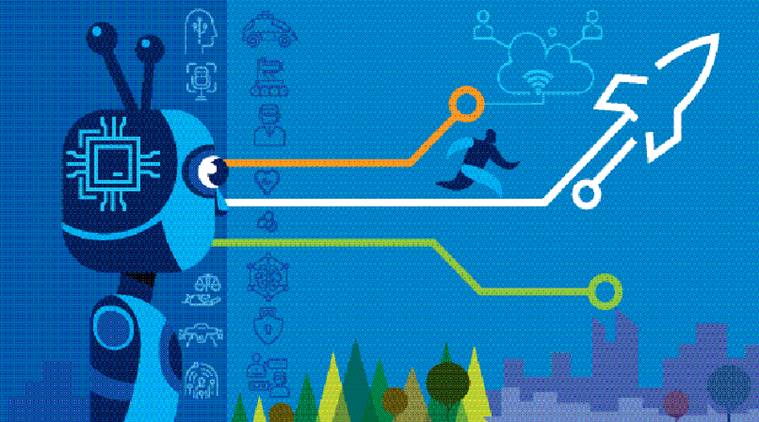Growth in the machine
If done right, artificial intelligence can jump-start India’s productivity, help the country get out of the emerging economy trap, propel it into the ranks of nations that matter.

How do we get India’s productivity to spike in 10 years? (Illustration: Shyam)
“India has perhaps now only a limited window of a decade to get into the developed country tag, or stay perpetually in the emerging group of economies. Policymakers, wake up and smell the coffee.” So says the SBI in a new report. Hyperbole and mangling of the English language aside, this dire warning seems a bit late. Ten years isn’t much time to plan an escape from the trap of permanent emergence. That said, I would not want to be disrespectful of the SBI, the country’s largest lender; so let’s take the warning seriously and, at least on paper, explore the outlines of an escape.
Given the abbreviated time, I must put aside my usual insistence on systemic solutions and look for the proverbial silver bullet. My pick would come down to one word — productivity. To get to the developed country status, this is one factor that has to change dramatically. This begs the question: How do we get India’s productivity to spike in 10 years? Note that even the most advanced economies have been struggling to replicate the productivity growth of earlier eras. This would seem odd in a golden age of technology, but, as Robert Gordon of Northwestern University has reminded us, today’s tech marvels are no match for the electrical breakthroughs of Thomas Edison, or for the early effects of trains, cars or airplanes. If the good professor is right and one has to top Thomas Edison, it would appear that India is done for. But wait. Google’s Sundar Pichai, who ought to know a thing or two about tech marvels, said recently that he has a marvel up his sleeve that will prove “more profound than electricity or fire”. He was talking about artificial intelligence (AI).
It is not just Pichai. AI — the simulation of human intelligence and learning by machines — has been talked about by many as the productivity booster we have all been waiting for. Unfortunately, as things stand, the odds are against it being India’s ticket into the developed nations club. While India is expected to be a player, it is far from being among the leading actors in AI. According to PwC, of the $15.7 trillion increase in global GDP in 2030 attributable to AI, $7 trillion will be in China, $3.7 trillion will be in the US and Canada. Accenture pegs the number for India to be below a trillion in 2035.
What is more, when you think about AI today, if you think about it at all, surely what must come to mind are the early indicators: Auto-corrects on phones, smart speakers and advertisements for those shoes you had once searched for but now doggedly follow you around the Internet. Around the corner, there are self-driving cars and cashier-less stores and smart streetlights. But then, one must ask, how many Indians really are affected by any of this? Under 30 per cent of the population has a smartphone. Road conditions in Indian cities are enough to drive any self-driving car algorithm insane. Much of India does not even have streetlights.
Without question, the race for AI dominance is between the US and China. However, despite its junior status — and this might come as a shock to some — there are, indeed, AI-relevant advantages unique to India. Three are particularly worth noting and give me reason for hope.
Versatile platform: With a billion-plus people populating the unique-ID system, Aadhaar, and the India Stack of digitally enabled offerings built on top of Aadhaar, the country has a platform for growth unlike any other in the world. It can, in principle, catalyse innovative applications, nurture an entrepreneurial ecosystem and generate a massive amount of data that can train algorithms and help develop more intelligence — the “I” in AI. To be sure, there are plenty of challenges to overcome: Getting the right participants, stakeholders and talent base to come together, providing capital and ensuring privacy, security and usability of the data. None of these can be taken for granted.
Key actors: The private sector is the biggest investor in AI. The good news is that India has an early start here. The global AI majors are active in India and view it as one of the world’s most promising digital growth markets; 58 per cent of the companies using AI in India are working with the technology at scale, according to Capgemini. This puts India in a clear third place behind the US and China and ahead of Europe. Europe’s more stringent data protection rules and regulations and slowing digital momentum will further constrain the interests of innovative companies. With economies of scale working in India’s favour, this could create a virtuous cycle of private sector AI investment and innovation activity.
Abundant applications: The truly game-changing applications of AI are not necessarily in smart speakers or self-driving cars. The technology can address long-standing societal and human development problems of the kind that abound in India. Think of tackling dengue and Chikungunya, two of the more formidable mosquito-borne public health crises. It is essential to get data on its incidence early and predict its path. Project Premonition, for example, an AI project of Microsoft, uses mosquitoes themselves as data collection devices. When a mosquito bites an animal, each bite contains DNA identifying the types of animals bitten, the type of mosquito-borne disease, and any unknown viruses. Drones can locate mosquito hotspots, robotic traps can collect bite specimens and AI will analyse the data and search for pathogens. In addition to this and other healthcare applications, AI can be used for myriad other purposes stretching across farming, transport, infrastructure, education and crime prevention — all productivity-boosting and job-creating applications ready and waiting across India. It is hard to find another country ready with these many deep value-creating AI applications.
India’s policymakers seem to have smelled the AI-flavoured coffee, albeit a bit late. The budget for Digital India was doubled; the IT ministry has formed four AI committees; the government’s think tank, the Niti Aayog, is tasked with coordination across AI initiatives. The Niti Aayog, for its part, has just announced an AI partnership with Google and has released a white paper, National Strategy for Artificial Intelligence.
But are we truly ready to meet the SBI challenge? I am afraid not. Fortunately, like the intelligence we have celebrated here, the SBI’s deadline is an artificial one, but it should be used by policymakers as a wake-up call. If Sundar Pichai is right about AI being as profound as electricity and India goes all in for AI, it will stand up and be counted among the nations that matter in the 21st century, even if that comes with an asterisk marking its “emerging” status. If done right, it can spike productivity, save lives and produce new livelihoods — jobs that the country’s youth desperately need. Not quite the discovery of fire, but jump-starting India’s abysmal productivity alone may be profound enough.
The writer is Dean of Global Business at The Fletcher School at Tufts University, founding executive director of Fletcher’s Institute for Business in the Global Context and non-resident senior fellow of Brookings India. He is author of The Slow Pace of Fast Change.
For all the latest Opinion News, download Indian Express App
More From Bhaskar Chakravorti
- One misstep too manyFacebook has egg on its face again and this time it might stick..
- Three un-Davos menThe culture of contradiction infused the speeches of Modi, Trump and Xi at the World Economic Forum...
- The Aadhaar opportunityIf UID project focuses on building a trustworthy system, India could be a leader in digital innovation..







































No hay comentarios:
Publicar un comentario